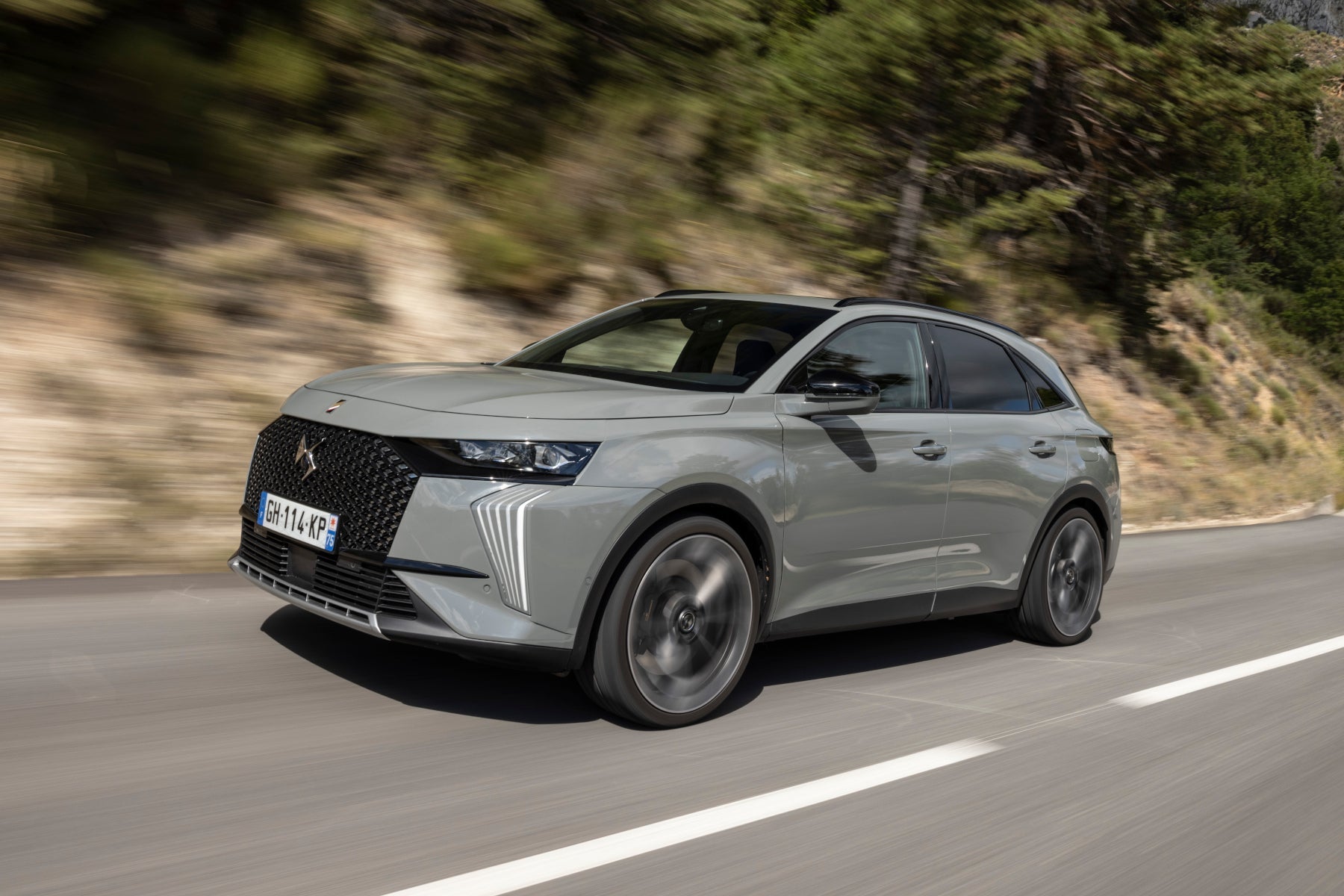DS 7 Review 2025: Price, specs & boot space
Written by Lawrence Allan
Quick overview
Pros
- Looks cool inside and out
- Cabin is roomy and upmarket
- Lots of standard equipment provided
Cons
- Driving experience lacks finesse
- Gets expensive further up the range
- Now hybrid or diesel only in 2022
Overall verdict on the DS 7
"The world of premium SUVs is dominated by the usual (and usually German) suspects. So perhaps the updated DS 7 offers something different from the norm? With plug-in hybrid or diesel power - plus a new high-performance E-Tense model - classy looks and a fully-loaded cabin, we'll see if it pays to move away from the norm in our DS 7 review."
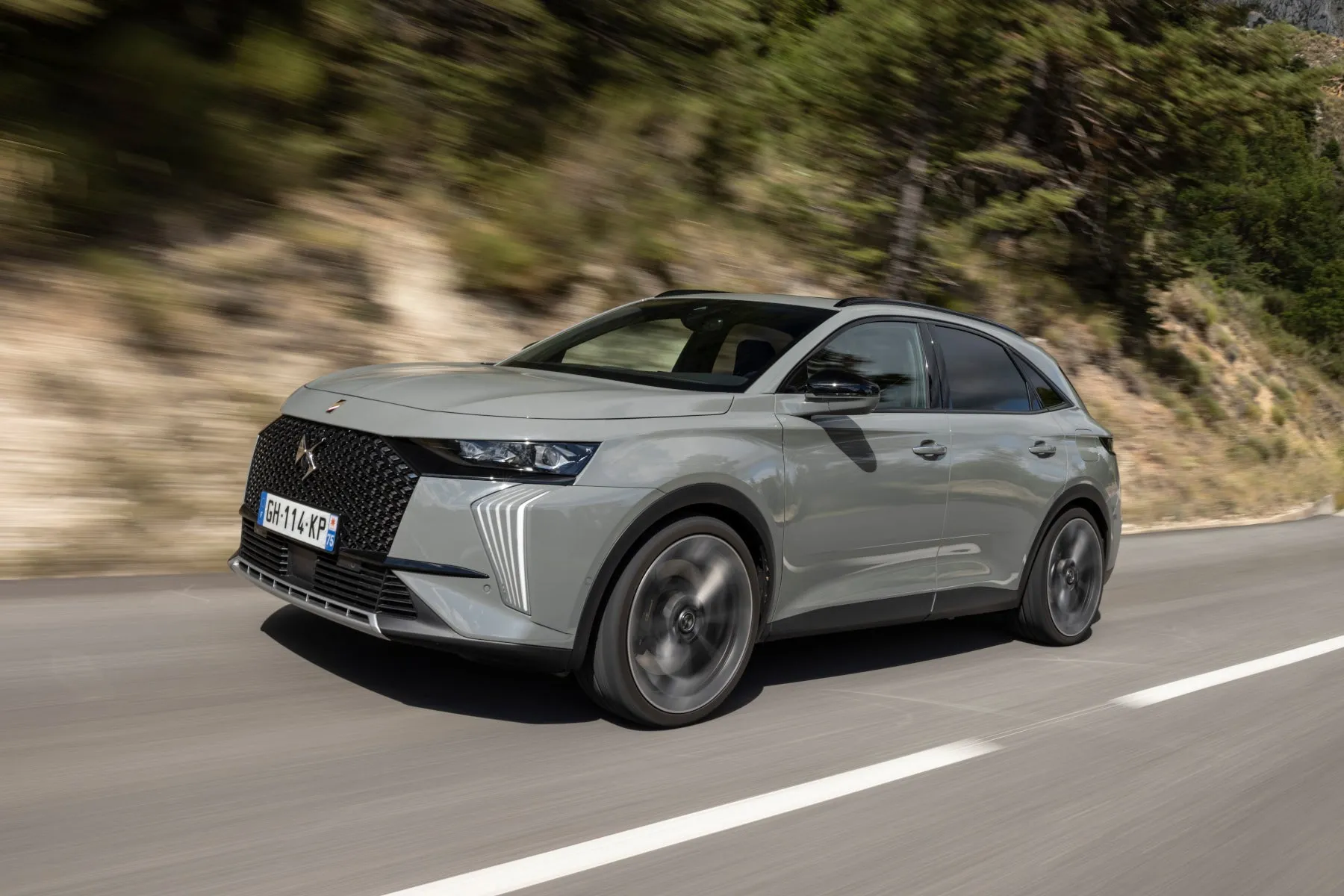
"Doesn't DS just make tarted up Citroens?" we hear you ask. Well, DS Automobiles is hoping its fresh range of bespoke cars will put that often-asked question to bed. The premium brand, part of the giant Stellantis group, has its sights firmly set on Audi, BMW and Mercedes with its four-strong model lineup.
Perhaps beating the all-conquering German trio at their own game is ambitious, but the French DS brand would at least like to unseat other established players such as Lexus, Jaguar and Volvo. It hopes to do so with the DS 3 Crossback small SUV, the competitive new DS 4, the DS 9 flagship limo and this, the recently updated DS 7 - a family SUV.
It's the artist formerly known as the DS 7 Crossback, with DS deciding its biggest SUV might be more appealing with a shorter, sweeter name. But more has been changed than that, with freshened-up styling, an improved cabin with upgraded tech and fresh additions to the engine range. DS hopes this will boost momentum for what is already its biggest seller.
Styling changes are more detail focused, but the DS 7 gets a redesigned grille, new headlights (fans might be up in arms that the old swivelling light units are no more) and suave new LED running light panels, new wheels, plus different lights and badging at the rear. The new DS 7 E-Tense performance model also gets lowered, firmer suspension and 21-inch alloys.
Even without the E-Tense additions the DS 7 is an elegant-looking SUV, although the excess of badging on the rear in different fonts is now a little messy. Compared to the straight-laced Volkswagen Tiguan or the common-as-muck BMW X3 it certainly stands out. Francophiles will also love that the DS 7 is the official transport of French president Emmanuel Macron.
There's plenty of opulence in the cabin, too, with plenty of flourishes and design details to make it feel special - even if some of the German brand's solidity is missing. The new infotainment is a welcome improvement and the equipment tally is extremely generous with standard features often only available as expensive options on rivals. There's also plenty of space in the five-seat cabin and a good-sized boot.
On the road the regular DS 7 prioritises comfort and refinement over encouraging the driver to chuck it around. It does a reasonable job of this but lacks the finesse of a good number of rivals, particularly with the bigger wheel options that come standard on many trims. It feels soft but doesn't isolate rough surfaces as well as we'd like, while the handling is quite floaty and unengaging.
The new flagship DS 7 E-Tense 4x4 360 helps rectify that with a firmer, sportier set-up. It's more controlled in the bends at the expense of some low-speed comfort, and combined with four-wheel drive it helps keep the top-spec plug-in hybrid's 360PS in check. While this version is pretty rapid it's expensive, and the lesser versions aren't exactly slow.
All of the hybrids offer the potential for extremely low fuel costs (if used correctly) and will save a lot of money for company car users. The diesel is more affordable, if best reserved for those doing big miles, and it's a pity there isn't a cheaper pure petrol model available any more for those buying or leasing a DS 7 privately. Still, the old DS 7 Crossback is available in petrol form for used buyers.
While the DS 7 does a decent job in most areas, it competes in a class where the best cars do an exceptional job in every area, and it simply can’t offer the same driving experience and mainstream appeal.
The DS costs the same amount, too (and even more in some trims) so it’s not like daring to be different will save you any money. Then again, if you like the way the DS 7 looks, and you like the idea of a left-field choice with lots of standard kit, then it could be a satisfying purchase. heycar has 1000s of used cars for sale, including a wide range of DS 7s for sale.
Is the DS 7 right for you?
Are you a fan of prestige SUVs like the Audi Q5, BMW X3 and Mercedes GLC, but not so much of a fan of the fact that everyone and their mum seems to have one? Are you also a little bit bored of the conservative styling that’s rife in cars of this type, and do you yearn for something a little bit, well, out-there? If so, the DS 7 could be just the car you’re looking for.
On both the outside and the inside, the DS 7 has unique art-deco styling that’s like nothing else in the class, giving a genuinely refreshing sense of individuality. It’s also a spacious and practical family car - crucial in any SUV - and it comes stuffed with luxury kit to help justify the fact that it doesn’t cost any less than the more established competition.
What's the best DS 7 model/engine to choose?
Buyers of the updated 2022 DS 7 are restricted to plug-in hybrids and a diesel. For most people we reckon the 225PS hybrid is the best bet. It's certainly not slow and offers a decent slug of all-electric range, so if you can plug it in at home you'll benefit from lower running costs.
In terms of trim on the new car the Performance Line+ (one step up from the entry-level Performance Line) offers everything you'd reasonably expect on a premium SUV under £50,000. The slightly pricier Rivoli trim does offer some extra niceties such as massaging leather seats, extra detailing inside and out and a posh B.R.M clock, however.
For used buyers the DS 7 Crossback has a wider range of engines available and we’d probably point most buyers towards the 180PS 2.0-litre diesel. It makes life easier and more relaxed than the 130PS entry-level car, and it copes better with motorway speeds and heavy loads.
There isn’t that much of a penalty to pay in purchase price or fuel economy, either. That said, if you’re a company car driver, you’ll want to consider the E-Tense plug-in hybrid version. Its super-low official figures for CO2 emissions make it by far the cheapest version on Benefit-in-Kind tax.
Trim-wise, we’d probably push you towards Prestige models. Entry-level Performance Line trim doesn’t want for much, but you’ll like a few luxuries in a car like the DS 7 and with heated leather seats that massage you, plus wireless charging for your phone, Prestige delivers them.
What other cars are similar to the DS 7?
The DS 7 assault on the super-popular premium mid-size SUV market, so there are three cars in its sights above all others: the Audi Q5, BMW X3 and Mercedes GLC. Well, if you’re going to pick a fight, it might as well be with the best in the business.
That’s by no means it, though. Other posh SUV rivals of this size and price point include the Volvo XC60, Jaguar F-Pace, Range Rover Evoque and Lexus NX, while there's also the Genesis GV70 if you really do want to stand out.
For those who don't mind not having a premium badge we'd also include high-end versions of the Volkswagen Tiguan, Mazda CX-60 and Hyundai Tucson as better value offerings.
Comfort and design: DS 7 interior
"The first thing that strikes you when you climb into the DS 7 is the interior design. It’s genuinely quirky and unconventional, with lots of interesting shapes and various funky-looking switches that successfully deliver an art-deco feel. Compared with the conservative cookie-cutter designs found in rivals, it’s refreshingly different."
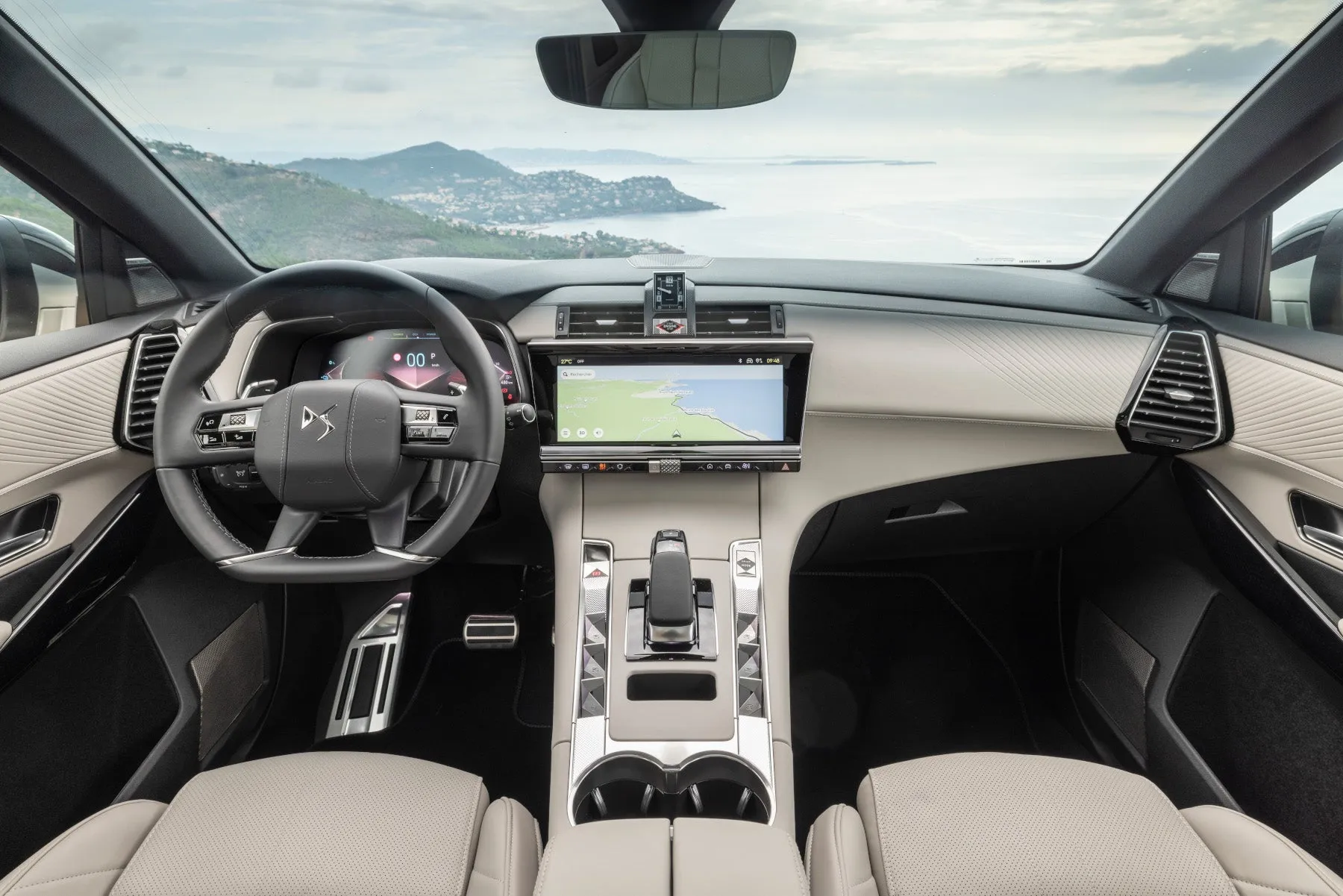
DS prides itself on offering a higher level of finish and material richness than models that share mechanical bits with the DS 7, such as the Peugeot 3008 and Citroen C5 Aircross. There's more choice of upholstery, posher detailing and some impressive equipment available.
The neat switchgear we mentioned control basic functions like the electric windows, door locking mechanisms and drive modes, and they’re pretty easy to use. However the window switches being in the middle of the centre console rather than on the doors takes some getting used to, while the engine start/stop button located at the top of the dash is a bit awkward.
Many other features are operated through the touchscreen system, however. This used to be a bit of a weakness on the old model but has now been improved, and we'll talk about that in a minute.
All versions get lots of adjustment for both the seat and steering wheel, allowing drivers of all shapes and sizes to find a comfortable position, and if you go for Performance Line+ trim and above the seats also move electrically, making things even easier. Rivoli trim also brings massaging functions, with ventilated seats on Opera trim, but whichever version you go for the front chairs are comfortable and reasonably supportive.
Visibility is pretty good, too, if not class-leading. However, nervous parkers will be comforted to know that all but the base model have parking sensors all-round and a reversing camera. Only top-spec Opera Premiere comes with a 360-degree camera feature, though, and many rivals have cleverer systems.
Quality and finish
The design of the DS 7’s interior definitely gives the cabin plenty of wow-factor, particularly in higher-end trims with lovely pearl-effect stitching on the leather on the dash and doors, high quality 'watch-strap' Nappa leather or Alcantara and that rotating clock at the top of the dash. The facelifted model brings some more interesting colour combinations than black-on-black, too.
It certainly feels like a more high-end driving environment than the mainstream alternatives, although there are a few less-than-perfect finishes such as the rather plasticky chrome-effect centre console trim and the odd harder plastic trim elements. It's in these areas where most other premium rivals pull ahead - despite the mix of fancy materials the overall quality feel isn't as cohesive as we'd like.
Used buyers will be happy to know that many of the high-end upholstery options still feature on the DS 7 Crossback, although some of the details of the updated car aren't available.
Infotainment: Touchscreen, USB, nav and stereo in the DS 7
The old DS 7 Crossback's infotainment looked decent enough, with a big screen size and standard digital dials, but the operating system both displays used was laggy and unintuitive.
DS has improved things with new software for the infotainment. The 12-inch screen and 12.3-inch dials are the same size as before, but the central touchscreen operates more quickly, the graphics are nicer and it has a more natural menu layout to make navigating to different functions more easy.
While the screen is less fiddly than before, we still wish there was a separate panel with knobs and buttons for the climate control like Jaguar, Lexus, Audi and BMW offer. DS will let you have, say, the sat-nav screen with the climate functions fixed either side, but faffing with the screen still isn't as easy. The touch sensitive shortcut buttons below are fiddly too, but we're glad DS has avoided Mercedes-style touch sensitive wheel controls.
Every version gets the same infotainment and digital dial combo, plus Android Auto and Apple CarPlay. But it's a shame you have to upgrade to Opera trim for simple tech such as wireless phone charging and two USB-C ports.
Top Opera Premiere trim does bring a couple of fancy features: there's a Night Vision function, which uses an infrared camera to display an image in the middle of the dials that sees further ahead than traditional headlights for extra safety on unlit roads. It will also pinpoint and highlight moving hazards you might not be able to see, such as an unlit pedestrian far ahead or an animal crossing the road. Opera Premiere also brings a Focal Electra audio system with 14 speakers.
Space and practicality: DS 7 boot space
The DS 7's exterior dimensions make it 4573mm long, 1895mm wide and 1635mm tall. It's not the largest SUV in its class, but it is longer than a VW Tiguan and approaching the size of an Audi Q5.
Space in the front and back is decently generous. Even large or broad adults will get comfortable up front, while in the rear there's enough legroom for six-footers to stretch out. The lack of a hump in the floor in the back means those sat in the middle seat aren't too squished, either.
A couple of caveats here: cars with the panoramic sunroof do lose out on a little bit of headroom, and while some rivals give you sliding rear seats that allow you to alter the bias between rear legroom and boot space, the DS 7’s rear chairs are fixed. Having said that, higher-end models do have an electric recline function on the rear seat backs, which is as nice touch.
The DS 7's 555-litre boot is big, though, big enough to compete with those of the best rivals, and you get a moveable floor that lets you either maximise space, or level out both the load lip and the step to the rear backrests when the seats are folded down. They do so in a 60-40 split (not as versatile as the 40/20/40 arrangement in a BMW X3) and although they don’t lie quite flat, there’s only a slight slope that you’ll have to contend with.
The other good news is that the PHEV version doesn’t lose any boot space compared with the rest of the range, not something that all hybrids - especially plug-in ones - can claim.
Handling and ride quality: What is the DS 7 like to drive?
"The DS 7 now has three different suspension set-ups as of 2022. Ride comfort ranges from soft but unsettled to firm but more controlled, while the E-Tense model is a powerful performer."
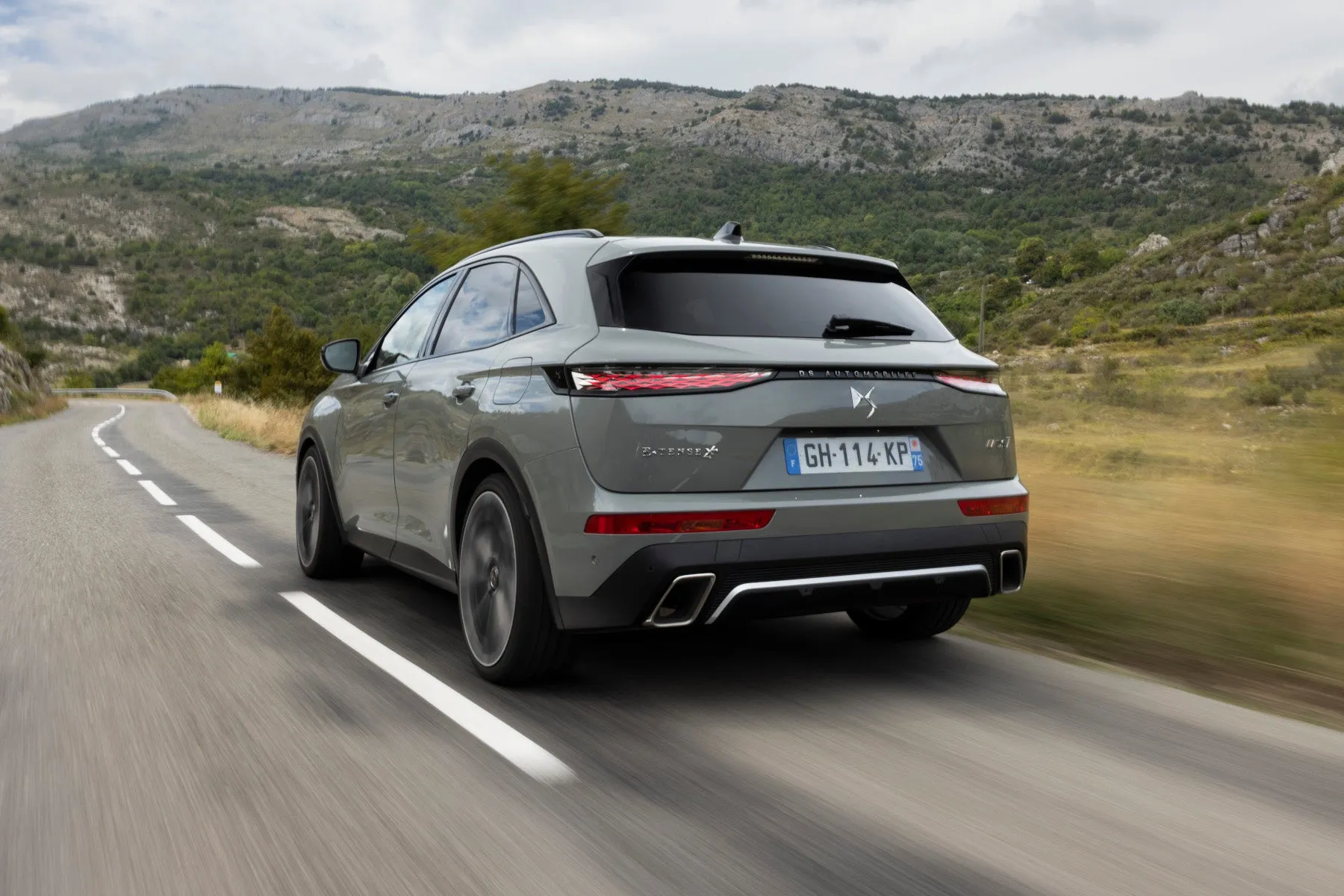
How your DS 7 feels to drive depends entirely on which version you go for. Entry-level DS 7 models have conventional suspension which is set up on the soft side - the ride is generally comfortable but only plush when you stick with the smallest wheel option. Even then, it struggles to stay smooth over small imperfections and can crash into larger ones.
All plug-in hybrid versions of the DS 7 come with the brand's Active Scan Suspension, with a camera that reads the road surface and is supposed to slacken or firm off the suspension to suit what's coming. It only works in Comfort mode and we wouldn't say the effect is profound, but it does help mitigate the extra weight of the hybrid models. The 20-inch or 21-inch wheel options do still offer a less controlled ride than the premium competition.
The most profound changes comes in the DS 7 E-Tense 4x4 360. This has 15mm lower, retuned suspension, plus a wider track (the space between the wheels across the width of the car), as well as upgraded brakes.
The upgrades do have a noticeable effect. On twisty roads the DS 7 E-Tense feels a lot more tightly controlled and eager to change direction, with the strong 4WD grip helping matters too. We'd stop short of calling it fun, but for such a heavy SUV it's well-sorted. At high speeds the E-Tense actually rides better than the standard car because it bounces around less, but with the standard 21-inch wheels it is a bit jarring on potholed low-speed roads.
In isolation the regular DS 7 models aren't too bad, but the competition in premium sectors is so good (with the BMW X3 and Jaguar F-Pace setting the benchmark) that it struggles to compete. Still, the steering is light when you want it to be and direct enough, while DS has improved the brakes on the plug-in hybrid models so they're less grabby and difficult to modulate at low speeds.
What engines and gearboxes are available on the DS 7?
As of 2022 the engine choice in the DS 7 is limited to one diesel engine and three (yes, really) plug-in hybrids.
The entry-level diesel, badged BlueHDI 130, is a carryover from the old model . The 225PS and 300PS hybrids are too (see below for our views on all of those), but the DS 7 E-Tense 360 4x4 is all-new.
As the name suggests it puts out 360PS, which combined with a hearty 520Nm of torque gives a punchy 0-62mph time of 5.6 seconds. It's certainly swift, although the main reason for upgrading from the 300PS version is actually the suspension upgrades as it doesn't feel noticeably faster.
Both four-wheel drive hybrids have oodles of power in reserve for overtaking, but the substantially cheaper 225PS model doesn't feel underpowered driven back-to-back, despite the three-second 0-62mph gap on paper. It's certainly fast enough to not be frustrating, if not as effortless. The same reservations about the hybrid gearbox reaction time remain, however (see below).
You get lots more choice on the old DS 7 Crossback, so listen carefully. Three turbocharged petrol options (badged PureTech) are offered, a 1.2 with 130PS, and 1.6s with either 180PS or 225PS. Diesel choices (badged BlueHDi) include a 1.5 with 130PS or a 2.0-litre with 180PS.
The E-Tense plug-in hybrid version, meanwhile, teams a 200PS version of the 1.6 petrol engine with a pair of electric motors to give 300PS. All of them are offered with an eight-speed automatic transmission, but the weakest petrol and diesel are also offered with a six-speed manual.
The entry-level BlueHDI 130 diesel will be adequate for most buyers most of the time. It’s perky enough in town, allowing you to trundle around at low speeds without too much fuss, but it takes a fair bit more time to pick up the pace and gets noisy while doing so.
For that reason, you’ll probably be better off with the bigger diesel if you spend a lot of time on motorways or regularly carry lots of passengers. It’s a useful amount quicker, but the bigger difference is that the performance just comes so much easier to the bigger engine, keeping things more relaxed.
The manual gearbox is fine: it’s not the smoothest or most satisfying shift you’ll ever encounter, but it’s easy enough and the clutch pedal is pleasantly light. The automatic, meanwhile, is pretty good. It slushes between gears smoothly and promptly, it’s good at giving you the right gear for your needs at the first time of asking, and it responds quickly enough when you shift manually with the paddles on the back of the steering wheel. It'll override your decision if it thinks it knows better, however.
The gearbox isn’t quite so impressive in the PHEV, though, because there's an irritating pause between you putting your foot down and anything happening. It'll also override your manual shifts, and when you're pushing on it keeps sending revs spiralling where the engine becomes rather boomy and strained.
That said, when the hybrid does figure things out and gets into its stride, the acceleration it provides is very impressive indeed. Drive more sedately at lower urban speeds, meanwhile and the electric motors will give you all the momentum you need to get around easily.
Refinement and noise levels
The DS 7's diesel engines have a similar level of refinement overall, but for slightly different reasons. The bigger engine transmits a few vibrations through to the cabin when it's ticking over, but doesn’t have to be worked as hard for much of the time, where the smaller engine is smoother under most circumstances, but gets a bit rattly when you wring it out. Both are fine, but neither is as smooth as the equivalent units in the Audi Q5.
The E-Tense, meanwhile, has something of a schizophrenic nature. Under all-electric propulsion, everything is impressively calm and subdued, but when the petrol engine chimes in, it has a distinctly coarse edge and sends too many vibrations through the controls, particularly when you rev it out.
Wind- and road noise are pretty well contained, so if you keep your engine revs as low as you can, the DS 7 makes a fairly relaxed motorway cruiser. As mentioned before, though, the older DS 7 Crossback has brakes that are a bit all-or-nothing on the plug-in hybrids as the car can't smoothly blend regenerative braking from the electric motors with proper braking through the, err, brakes. That takes some getting used to, but is improved on the new DS 7.
Safety equipment: How safe is the DS 7?
All DS 7s come with plenty of safety kit as standard, but the precise level of equipment you get depends on the trim level. All versions get active LED headlights with high-beam assistance, six airbags, tyre pressure monitoring, a space-saver spare wheel (on all but the PHEV), speed limit recognition, lane-departure warning and automatic emergency braking.
Prestige cars add blind spot monitoring, while Ultra Prestige adds adaptive cruise control with steering assistance and stop-go functionality, meaning the car can effectively drive itself in certain situations. All that has helped the DS7 achieve the full five-star rating in Euro NCAP crash tests.
Safety equipment levels are similar on the facelifted DS 7, but the adaptive cruise control with lane positioning and steering assistance is now upgraded as DS Drive Assist.
Maximum EV range on the DS 7 E-Tense
According to the official WLTP figures, the E-Tense 225PS version of the DS 7 should be able to cover between 39 and 49 miles on electric power alone on a full charge, but that's optimistic in our experience (the latter figure is for city use where you're braking and recharging the battery a lot).
The E-Tense 300 4x4 version promises between 38 and 49 miles of range, while the 360 variant brings that down to between 35 and 38 miles. In the real world, a figure of up to 30 miles is more realistic in optimum conditions, and that will drop significantly if it’s cold or you're doing a lot of high-speed driving. That said, being a PHEV, electric range is less of an issue because there’s a petrol engine on hand to help out if necessary.
On all versions a single charge takes 1 hour and 45 minutes from a 7kW wallbox home charger, which most drivers will have fitted. That increases to around 7 hours from a standard three-pin plug socket.
MPG and fuel costs: What does the DS 7 cost to run?
"Look at the maximum combined WLTP figures for each engine, and they look pretty competitive with those of rivals. The plug-in hybrids get thirsty if you run out of battery charge, however. "
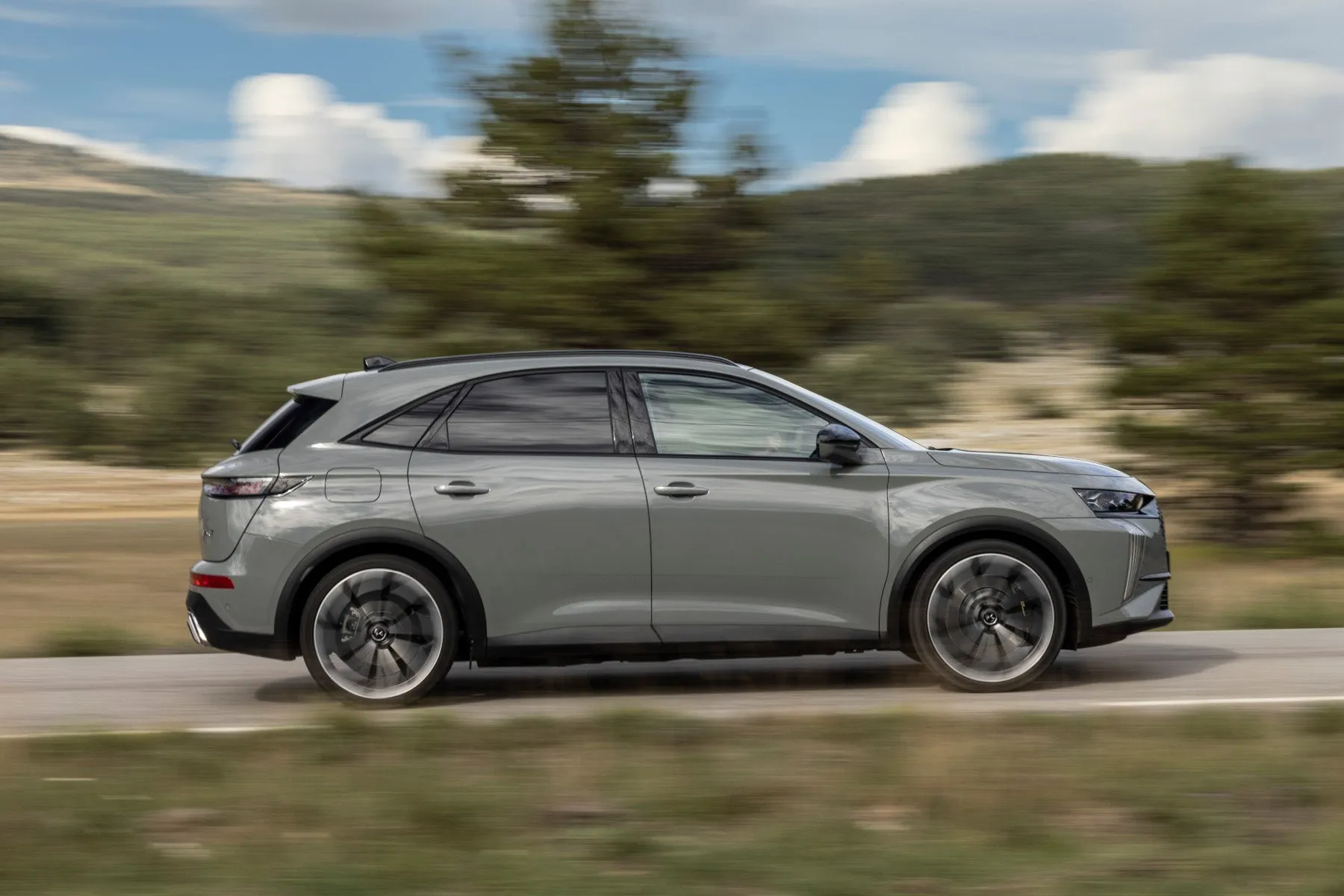
On the new DS 7 its the E-Tense plug-in hybrids that are the star of the show in fuel economy terms - on paper at least thanks to the WLTP figures.
Up to 229 miles is apparently possible on the 225 version, falling to up to 222mpg on the 4x4 300. No figures are yet quoted for the 360 version but expect an official figure over 200mpg. Good luck matching that in the real world, though, unless you only use it with battery charge left over.
You’ll maximise your return by spending as much time as you can on electric-only power, but as soon as your petrol engine kicks in, your average figure will plummet. On longer journeys with a depleted battery you'll be lucky to crack 40mpg in any of them.
The best figures for the various DS 7 Crossback petrol engines range between 40mpg and 46mpg, while the best figure for the smaller diesel stands at 55mpg (slightly less for the manual than the automatic) and the brawnier diesel gets around 48mpg.
Even these figures look pitiful compared with those of the PHEV version, which depending on the spec of your car, will deliver maximums of between 166mpg and 235mpg, according to the laboratory figures.
How reliable is the DS 7?
DS didn't feature in the latest HonestJohn.co.uk Satisfaction Index, but the related Stellantis brands (Peugeot, Citroen and Vauxhall) all finished in the bottom third. The scoring is pretty close so we wouldn't expect lots of serious issues and the engines have been around for some time, but we also can't say definitively how reliable it will be in the long-term.
Insurance groups and costs
There’s huge variation in insurance groupings between versions of the DS 7. The vast majority sit between groups 20 and 30 (out of 50), depending on their power output and price, making them fairly middle-of-the-road in terms of the insurance premiums they command. However, the hybrids, what with their prodigious power, sit in insurance group 37 to 39, making them noticeably pricier to insure.
VED car tax: What is the annual road tax on the DS 7?
Because the DS 7 was released in 2018, all versions are subject to the latest regulations on VED tax that imposed a flat rate for petrol and diesel cars, a reduced rate on alternative fuel cars, and a £325 surcharge for cars costing more than £40,000 when new.
Most petrol and diesel versions cost less than the threshold without options, so provided the car you’ve found isn’t laden with enough extras to take it over the edge, you’ll pay an annual VED of £150.
If it is, or if it’s one of the higher spec versions that cost more than £40k, you’ll pay £475 up until year six of the car’s life, and then £150 thereafter. All hybrid versions qualify for a reduced basic rate of a tenner (whoop-de-doo), but because all of them cost more than £40k when new, annual tax bills on those will be £465 between years two and six, and then £140 thereafter.
Buying a new DS 7 in 2022? The surcharges have increased further still, as have list prices. Almost all of the DS 7 models are over the £40k 'premium car' surcharge figure and subject to £355 on top of the first year rate of the standard rate (now £165) for five years. Hybrids get a discount to £155 still.
How much should you be paying for a used DS 7 Crossback?
"In 2022, prices for the new DS 7 start from just under £37,000 for the base diesel to £63,000 for the poshest and fastest plug-in hybrid. But you'll get a used one for an awful lot less from our dealers."
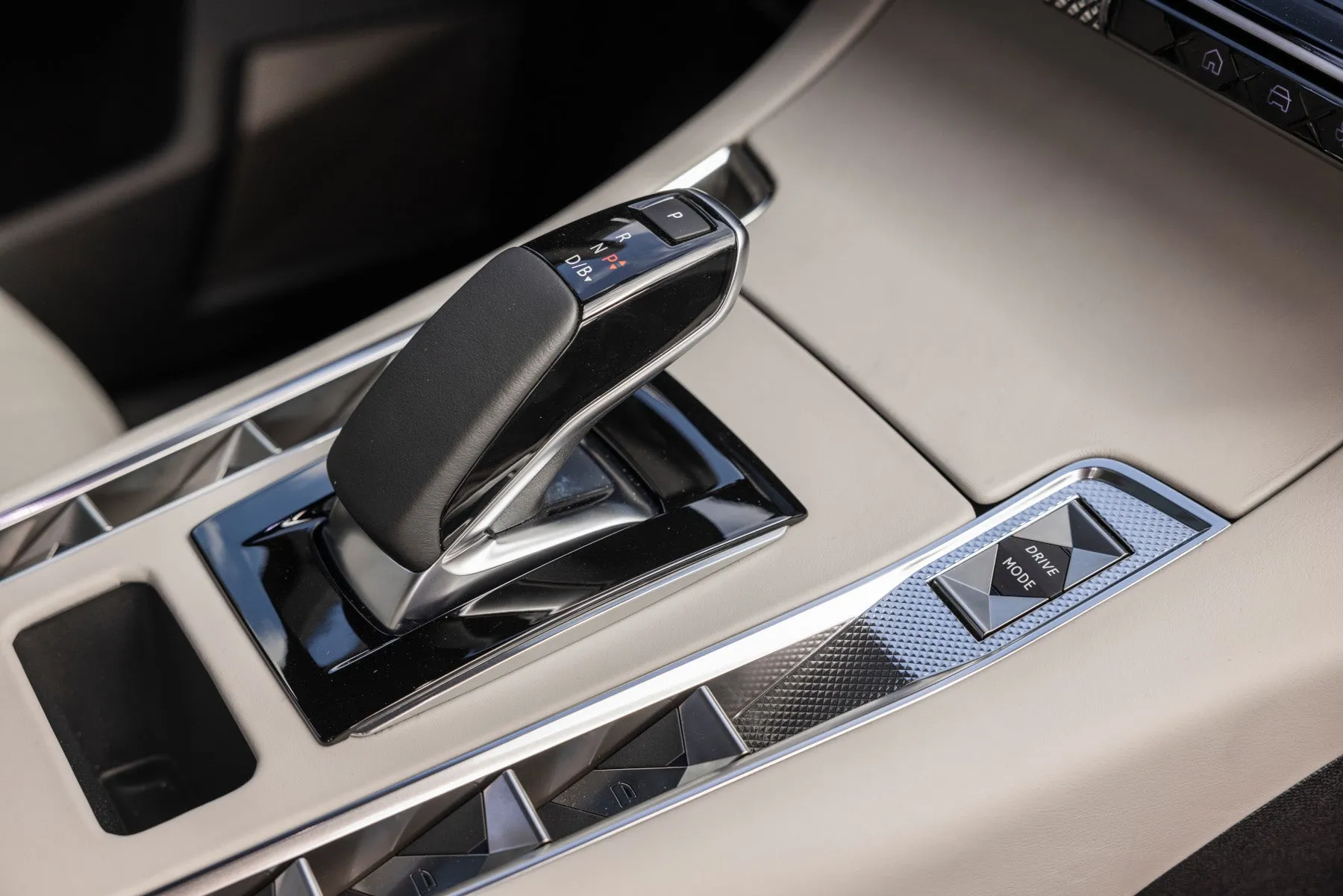
The base price of the 2022 DS 7 manages to undercut key premium rivals, although that's for the base 1.5-litre diesel and few competitors offer such a low-powered variant.
Get into the plug-in hybrids and, while they might look pricey on paper, prices of hybrid rivals have risen considerably too (even the cheapest X3 30e PHEV is over £53,000 now). But we can hardly call high-end versions of the DS 7 value offerings - not when the Mazda CX-60 tops out and under £50k.
Depreciation is relatively steep as you tend to see from large, posh French cars, making a used DS 7 noticeably cheaper than rivals spec-for-spec. Prices start from around £15,000 for a high mileage, lower-spec 2018 diesel, but you'll need £20k for one with around 35,000 miles.
Petrol models start at £21,000, but the hybrids arrived later and you'll need at least £34,000 for a 2021 E-Tense Performance Line with 9000 miles on the clock.
Trim levels and standard equipment
Even the entry-level DS 7 Performance Line is well stocked with 19-inch alloy wheels, LED headlights, Alcantara trim, two-zone climate control, keyless entry and start, cruise control, rear parking sensors and automatic lights and wipers, plus all the infotainment and safety kit mentioned earlier.
In 2022 a DS 7 Performance Line+ trim was added, bringing black roof rails, a reversing camera, front parking sensors, electric heated front seats, a premium leather steering wheel and a heated windscreen. It's well worth the upgrade.
That said, we reckon many drivers will still want to upgrade to the DS 7 Prestige (now called the DS 7 Rivoli) for its grained leather upholstery, massaging seats, rear seats that recline electrically, extra chrome and interior details and a B.R.M clock.
The DS 7 Ultra Prestige (now called DS 7 Opera) brings quilted 'watch-strap' leather, an electrically opening panoramic roof, an electric tailgate, wireless phone charging and ventilated front seats. It also adds DS Drive Assist, the Level 2 driver assist system with adaptive cruise control.
The top-spec DS 7 La Premiere receives an upgraded Focal sound system, 21-inch wheels, a 360-degree camera, night vision and hands-free access for the electric tailgate.
Various other editions came and went periodically over time, with fabulously fancy names such as Elegance, La Premiere, Be Chic, So Chic and Grand Chic. Ooh-lah-lah.
Ask the heycar experts: common questions
What brand makes the DS 7?
Does the DS 7 have seven seats?
Can a DS 7 tow a caravan?
Get our latest advice, news and offers
Keep me updated by email with the latest advice, news and offers from heycar.
By submitting you agree to our privacy policy
